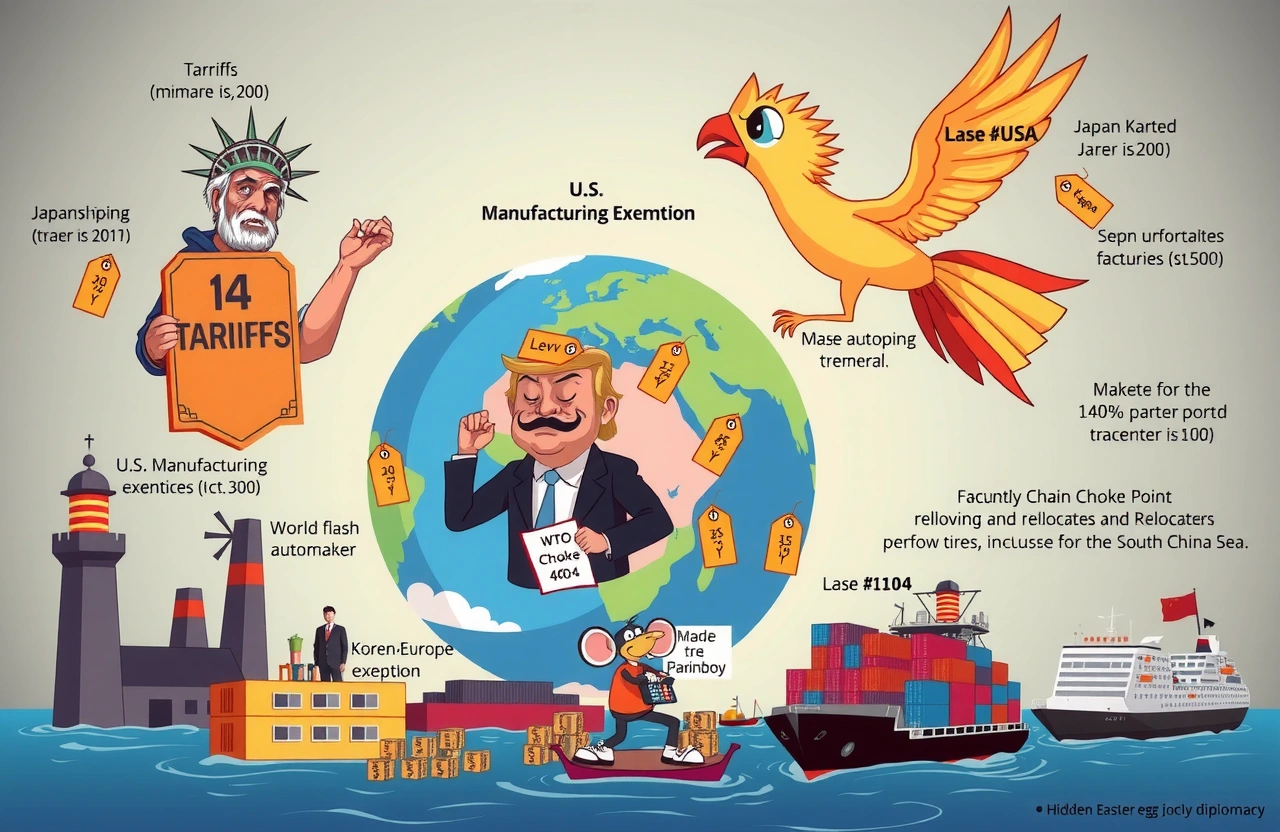Tectonic Shift in Global Trade Policy
In a move poised to reshape international commerce, former President Donald Trump initiated sweeping global trade tariffs targeting 14 nations across Asia, Europe, and Africa. The unprecedented tariff schedule revealed on July 7 ranges from 25% for Japanese and Korean imports to 40% for products from Laos and Myanmar – the highest rate Trump ever imposed. Letter recipients included Japanese Prime Minister Shigeru Ishiba (石破茂) and South Korean President Lee Jae-myung (李在明), signaling direct pressure on critical U.S. allies.
Key Developments
- 14 countries face new tariffs effective August 1, with rates tiered by nation
- Highest impacts: Laos/Myanmar (40%), Cambodia/Thailand (36%), Bangladesh/Serbia (35%)
- Japan/Korea targeted at 25% despite existing trade agreements
- White House clarifies tariffs won’t stack atop existing industry levies
- Threats of secondary tariff escalations if nations implement countermeasures
Breaking Down the Tariff Structure
The tariff matrix released through presidential letters establishes regionally calibrated rates targeting specific trade imbalances. Unlike broad Sino-U.S. trade war measures, this approach surgically pressures partners Trump considers ‘trade abusers’ based on bilateral deficit calculations.
Regional Tariff Implementation
- East Asia: Japan & Korea (25%), Indonesia (32%)
- Southeast Asia: Thailand (36%), Malaysia (25%), Cambodia (36%)
- Africa: Tunisia (25%), South Africa (30%)
- Europe: Bosnia-Herzegovina (30%), Serbia (35%)
Global trade tariffs now explicitly link tariff percentages to perceived trade inequities. Trump’s letter to Japanese Prime Minister Ishiba (石破茂) stated: ‘25% falls considerably below the level needed to eliminate our trade imbalance’ – framing tariffs as mathematical remedies rather than punitive measures.
Red Carpet for Onshoring Alternatives
A critical exemption exists: Companies establishing U.S. manufacturing operations avoid tariffs entirely. Trump pledged ‘rapid, professional approval within weeks’ for firms relocating production – positioning tariffs as leverage for domestic job creation.
How Production Shifting Works
- Complete tariff waiver for made-in-America goods
- Streamlined regulatory approval for new facilities
- Third-country transshipment face heavier penalties
This provision particularly pressures Korean automakers and Japanese electronics firms maintaining overseas production hubs. Analysts warn global trade tariffs could accelerate supply chain relocations regardless of tariff outcomes.
Retaliation Threats and Escalation Risks
‘If you impose reciprocal tariffs, we will add equivalent tariffs atop existing rates,’ Trump explicitly warned President Lee Jae-myung (李在明). This positions tariffs as baseline, not ceiling – creating unprecedented escalation scenarios where Korean imports could jump from 25% to 50% overnight.
Global Backlash Intensifies
International condemnation emerged swiftly:
- Brazil’s President Lula denounced Trump’s ‘irresponsible protectionism’
- Chinese Foreign Ministry: ‘Trade wars yield no winners’
- WTO monitoring potential rule violations
Notably, targeted countries constitute critical links in global supply chains – Thailand produces 30% of world’s hard disk drives while Malaysia accounts for 7% of semiconductor exports. Disruptions could cascade through manufacturing ecosystems.
The Tariff Stacking Dilemma Clarified
Amid market confusion, White House officials confirmed global trade tariffs won’t compound with existing duties stemming from:
- Steel/aluminum tariffs under Section 232
- Section 301 intellectual property protections
- Industry-specific anti-dumping duties
This prevents ‘tariff stacking’ – multiple levies on single products – while leaving intact Trump’s Executive Order 14289 establishing tariff hierarchy protocols.
Strategic Positioning Ahead of Elections
The August 1 implementation coincides strategically with:
- US presidential campaigning intensification
- Congressional review deadlines for trade measures
- Third-quarter corporate supply chain reshuffling
Global trade tariffs serve dual political and economic purposes – energising Trump’s protectionist base while pressuring trading partners for concessions before potential administration transition.
Business Adaptation Pathways
Export-dependent nations face three options:
- Absorb tariffs through compressed profit margins
- Redirect exports through tariff-exempt nations (risking penalty clauses)
- Establish US manufacturing footholds within anti-tariff safe harbors
Importers should audit supply chains immediately using Harmonized System codes cross-referenced against Treasury Department’s tariff schedule.
Preparing for New Trade Realities
With August compliance deadlines approaching, multinationals need pivot strategies accounting for cascading secondary impacts when tariffs inevitably reshape:
- Finished goods pricing structures
- Component sourcing lanes
- Warehousing/distribution footprints
The global trade tariffs blueprint may expand to other nations unless recipient nations broker exemption deals – Trump’s letters explicitly framed tariffs as adjustable ‘starting points.’
Call to Action for Trade Partners
Global trade tariffs represent temporary dislocations while rebalancing fundamentally asymmetrical relationships. Rather than retaliating with tariff walls that shrink markets, strategic partners should:
- Initiate bilateral deficit-reduction talks
- Showcase US investment commitments
- Collaborate on advanced manufacturing R&D
- Appeal jointly through WTO dispute channels
History demonstrates tit-for-tat tariffs hemorrhage economic value collectively. Forward-looking trade diplomacy remains viable despite protectionist posturing – provided stakeholders engage strategically before August implementation triggers irreversible consequences.




